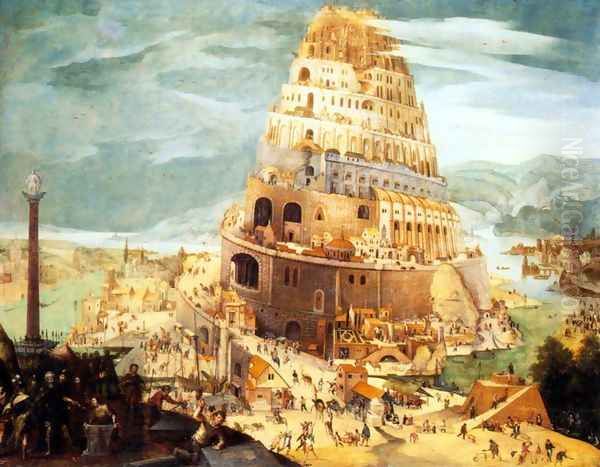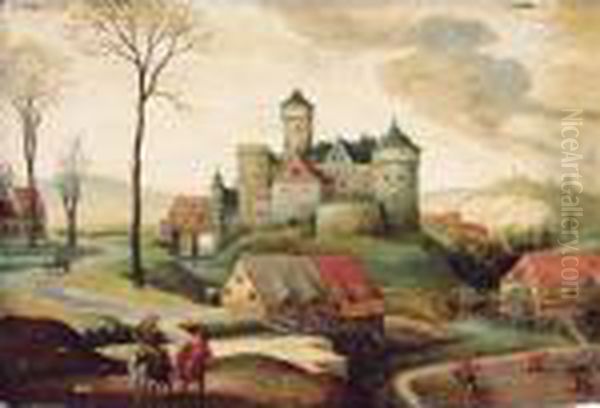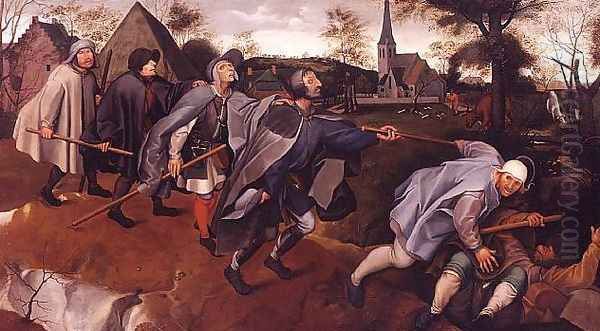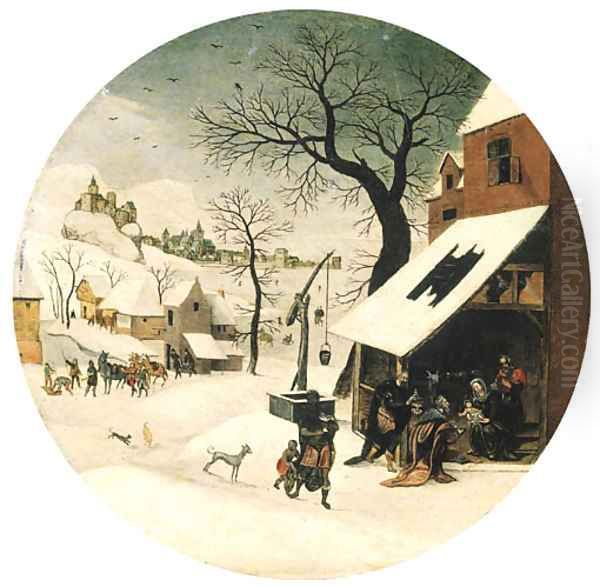Introduction: An Antwerp Painter in Transition

Abel Grimmer (circa 1570 – circa 1620) stands as a significant figure in Flemish art during the late Renaissance and the transition towards the early Baroque period. Active primarily in Antwerp, the bustling artistic and commercial heart of the Southern Netherlands, Grimmer carved a niche for himself as a prolific painter of landscapes, architectural views, and genre scenes often imbued with biblical narratives. Born into an artistic family, he inherited not only his father's workshop but also a deep connection to the rich traditions of Flemish landscape painting, particularly the influential legacy of Pieter Bruegel the Elder. Grimmer's work is characterized by its clarity, harmonious colour palettes, and a distinctive blend of observed detail and stylized simplification, making his paintings both accessible and aesthetically pleasing. He represents a generation of artists who absorbed the innovations of the 16th century and adapted them for a growing market, contributing significantly to the visual culture of his time.
Early Life, Training, and Guild Membership
Born in Antwerp around 1570, Abel Grimmer's entry into the world of painting was almost preordained. He was the son of Jacob Grimmer (c. 1526 – before 1590), himself a respected and successful landscape painter known for his contribution to the development of naturalistic landscape depiction in Flanders. It was under his father's tutelage that Abel received his initial artistic training, learning the techniques and compositional strategies prevalent in the family workshop. This direct lineage provided him with a solid foundation in the craft and likely exposed him early on to the popular themes and styles of the day, including the enduring influence of Pieter Bruegel the Elder, whose work Jacob Grimmer admired and sometimes emulated.

Following his father's death, Abel Grimmer appears to have taken over the workshop, continuing the family business. His formal entry into the professional art world of Antwerp is marked by his registration with the city's prestigious Guild of Saint Luke. Records indicate he became a free master in the Guild in 1592, a crucial step that allowed him to operate independently, sign his own works, and take on apprentices. Some sources suggest an initial membership registration in 1591 followed by the master status in 1592. Regardless of the precise year, this affiliation cemented his position within the Antwerp artistic community. He remained based in Antwerp throughout his career, contributing to the city's vibrant artistic output until his death around 1619 or 1620.
Artistic Style: Clarity, Color, and Composition
Abel Grimmer developed a distinctive and recognizable artistic style, marked by a preference for clarity, order, and decorative appeal. While deeply influenced by the panoramic scope and peasant life themes of Pieter Bruegel the Elder and the detailed, often miniaturist precision found in the works of Hans Bol, Grimmer forged his own path. His style is often described as simplified and systematic, particularly in the rendering of figures and natural elements. He employed clear, often crisp lines and favoured compositions with a strong sense of geometric structure and spatial recession, often utilizing a tripartite colour scheme (brown foreground, green middle ground, blue background) typical of the era's landscape conventions, but executed with a characteristic softness and harmony.
His palette is notable for its subtle and harmonious colour contrasts, often favouring bright, clear hues that lend his paintings an optimistic and serene atmosphere. Unlike the more rugged or dramatic naturalism sometimes found in Bruegel's work, Grimmer's landscapes often feel more idealized and tranquil. He demonstrated a keen sensitivity to light and atmosphere, effectively capturing the nuances of different times of day and seasons. This blend of naturalistic observation, particularly evident in his rendering of light and specific landscape features, with a tendency towards simplification and stylization places him as a transitional figure, carrying forward Renaissance ideals while hinting at the emerging Baroque interest in light and mood. His brushwork is typically meticulous and controlled, contributing to the overall finish and detailed quality of his panels.
Themes and Subject Matter: Seasons, Scriptures, and Scenery

Abel Grimmer's oeuvre revolves around several key themes, with landscape serving as the predominant stage. He is perhaps best known for his numerous series depicting the Months of the Year or the Four Seasons. This genre, popularized by Pieter Bruegel the Elder's seminal series, offered artists a framework to explore the cyclical nature of life, agricultural activities, and changing landscapes throughout the year. Grimmer produced many such sets, often on small, circular or rectangular panels, which were highly sought after for domestic interiors. These series allowed him to showcase his skill in depicting diverse weather conditions, atmospheric effects, and the varied activities associated with each month or season, from sowing and harvesting to skating and feasting.
Within these landscapes and seasonal depictions, Grimmer frequently integrated biblical narratives or parables. Rather than placing these scenes in historically accurate Near Eastern settings, he followed the common Northern European convention of situating them within contemporary Flemish landscapes and villages. This approach made the sacred stories more relatable to his audience and allowed him to blend religious instruction with charming depictions of local life. Scenes like the Parable of the Sower, the Good Samaritan, or Old Testament stories unfold amidst familiar fields, villages, and architectural backdrops. This integration of the sacred and the secular is a hallmark of his work, reflecting the religious and cultural context of post-Reformation Antwerp.
Beyond the seasonal cycles and biblical themes, Grimmer also painted pure landscapes, village scenes, and architectural views. His depictions of rural life often echo Bruegel's interest in peasant activities but tend to present them in a more orderly and less earthy manner. The emphasis is often on the harmonious coexistence of humanity and nature, rendered with his characteristic clarity and pleasing colour schemes. These works catered to a growing urban demand for images of the countryside, offering idyllic visions of rural peace and productivity.
Master of Architectural Views
While renowned for his landscapes, Abel Grimmer also possessed considerable skill as an architectural painter. He produced numerous depictions of church interiors, townscapes, and imaginary architectural settings like the Tower of Babel. His church interiors, often portraying Gothic structures, demonstrate a sophisticated understanding of perspective and the play of light within complex spaces. He meticulously rendered architectural details – columns, vaulting, altarpieces, stained glass windows – creating convincing illusions of depth and volume. These interiors are often populated with small figures, adding a sense of scale and activity, sometimes depicting specific biblical events occurring within the church setting, such as Christ among the Doctors or the Presentation in the Temple.

His depictions of cityscapes, sometimes representing identifiable locations like Antwerp, showcase his ability to handle complex panoramic views. He organized intricate urban environments with clarity, capturing the unique character of Flemish towns with their stepped gables, market squares, and waterways. These works often combine topographical accuracy with genre elements, depicting the daily bustle of city life. The careful rendering of buildings, streets, and public spaces highlights his attention to detail and his interest in the built environment as a subject in its own right. This focus on architecture distinguishes him somewhat from his father, Jacob, and aligns him with other specialists in this genre emerging in the Low Countries.
The Series Paintings: Months and Seasons Revisited
The series depicting the Twelve Months or the Four Seasons represent a significant portion of Abel Grimmer's output and are central to understanding his working methods and market appeal. These series were often based on popular print series, particularly those designed by Hans Bol and engraved by artists like Adriaen Collaert or Pieter van der Heyden (who engraved many of Bruegel's designs). Grimmer skillfully adapted these black-and-white print compositions into colourful panel paintings. He would often replicate the overall design but translate it into his own distinct style, characterized by his specific colour choices, atmospheric rendering, and simplified treatment of figures.
These series were typically produced on small, often circular, panels, suggesting they were intended for intimate viewing in domestic settings, perhaps set into furniture or wall paneling. The repetition of compositions across different sets indicates a highly organized workshop practice geared towards efficient production to meet market demand. While based on existing models, Grimmer's painted versions offered the added appeal of colour, texture, and the unique qualities of oil paint, transforming the graphic sources into luminous and charming objects. Examples like Winter: Skating at a Castle, often featuring skaters on frozen moats or rivers near villages, capture the crisp atmosphere and communal activities of the season with characteristic charm and clarity, directly referencing famous prototypes by Pieter Bruegel the Elder but rendered in Grimmer's smoother, brighter style.
Representative Works: Signature Themes

Several works stand out as representative of Abel Grimmer's style and thematic concerns. The Tower of Babel is a subject he painted on multiple occasions, following a tradition popular among Flemish artists, including his father Jacob Grimmer, Marten van Valckenborch, Lucas van Valckenborch, Hendrick van Cleve III, and famously Pieter Bruegel the Elder. Grimmer's versions typically depict the colossal structure dominating a vast landscape, meticulously detailing the brickwork, ramps, and bustling construction activity. These paintings served as cautionary tales about human hubris, based on the biblical story from Genesis, while also providing an opportunity for the artist to display his skill in rendering complex architecture and panoramic vistas. His interpretations often emphasize the intricate details of the construction process within a wide, atmospheric landscape.
His numerous paintings belonging to the Months of the Year series are collectively a major part of his legacy. Individual panels, such as those representing January (often depicting feasting or winter activities), April (showing gardening or pastoral scenes), July (haymaking or harvesting), or December (pig slaughtering or winter landscapes), exemplify his approach. For instance, a panel depicting Winter landscape with skaters and a bird trap, directly inspired by Bruegel's famous painting, showcases Grimmer's ability to capture the cold light and specific details of a winter scene – the bare trees, frozen water, bundled figures, and the eponymous bird trap – all rendered with his characteristic clarity and slightly stylized forms. These works highlight his engagement with the Bruegelian tradition and his skill in adapting it into his own appealing visual language. A fine example of his church interiors might depict the Interior of a Gothic Church with Elegant Figures, showcasing his mastery of perspective and light.
The Question of Originality and Workshop Practice
Art historical assessments of Abel Grimmer have sometimes grappled with the issue of originality, given his frequent reliance on compositions originated by other artists, primarily Pieter Bruegel the Elder and Hans Bol, often accessed through prints. He has occasionally been labelled as a mere copyist or imitator. However, this perspective needs to be contextualized within the artistic practices of the late 16th and early 17th centuries. In this period, the concept of artistic originality differed significantly from modern notions. The repetition and adaptation of successful compositions were standard workshop practices, driven by market demand and the desire to disseminate popular imagery.

Artists like Grimmer and his contemporary Pieter Brueghel the Younger built successful careers by specializing in the reproduction and variation of works by renowned masters like Pieter Bruegel the Elder. Their contribution lay not necessarily in inventing new compositions but in the skillful translation of these designs into the medium of painting, adding colour, atmosphere, and their own stylistic nuances. Grimmer's versions are distinguished by their high level of craftsmanship, harmonious colour schemes, and consistent quality. He was not simply tracing but reinterpreting, creating works that were highly valued in their own right for their decorative qualities and technical execution. His success suggests that his patrons appreciated his particular take on these established themes and compositions.
Contemporaries, Collaborations, and Wider Context
Abel Grimmer worked within the vibrant artistic milieu of Antwerp, a city teeming with painters, printmakers, and dealers. His primary influence, besides his father Jacob Grimmer and the towering figures of Pieter Bruegel the Elder and Hans Bol, came from the broader traditions of Flemish landscape and genre painting. He was a contemporary of Pieter Brueghel the Younger (1564-1638), who similarly specialized in producing versions of their father's compositions. While their subject matter often overlapped, their styles differed, with Grimmer's work generally characterized by a brighter palette and smoother finish compared to the often more robust and earthy style of the younger Brueghel.
Other notable contemporaries in Antwerp and the wider Flemish context included landscape specialists like Joos de Momper (1564-1635), known for his fantastical mountain landscapes, Tobias Verhaecht (1561-1631), an early teacher of Peter Paul Rubens, and Gillis van Coninxloo (1544-1607), a pioneer of forest landscape painting. Genre painters such as Sebastiaen Vrancx (1573-1647), known for battle scenes and elegant companies, and David Vinckboons (1576-c.1632), active in both Antwerp and Amsterdam, were also part of this artistic landscape. Artists like Paul Bril (1554-1626), who worked primarily in Rome, helped spread Flemish landscape conventions internationally. The Valckenborch family, including Marten van Valckenborch (1535-1612) and Lucas van Valckenborch (c.1535-1597), also explored similar landscape and allegorical themes.
Regarding collaboration, while Abel inherited his father Jacob's workshop, direct evidence of collaboration between them is scarce, partly due to the father's death relatively early in Abel's independent career. Speculation about collaborations with other artists, such as Hendrick van Cleve III (c.1525-1589) or Marten van Cleve (c.1527-1581), remains largely unsubstantiated by documentary evidence, though stylistic similarities or shared themes sometimes prompt such suggestions. His reliance on printmakers like Adriaen Collaert (c.1560-1618) and Pieter van der Heyden (c.1530-1572) for source material, however, is well-established.
Later Life and Legacy
Abel Grimmer continued to work productively in Antwerp throughout the early decades of the 17th century. His consistent style and appealing subject matter ensured a steady market for his paintings. He maintained the family workshop tradition, producing numerous panels that found their way into collections across Flanders and beyond. He died in Antwerp around 1619 or 1620, leaving behind a substantial body of work.
His legacy lies in his role as a skilled interpreter and popularizer of the Flemish landscape tradition established by Bruegel and further developed by artists like Bol. While perhaps not a radical innovator in terms of composition, Grimmer excelled in creating beautifully crafted, harmoniously coloured, and atmospherically sensitive paintings that captured the spirit of his time. His work exemplifies the transition from the detailed, narrative style of the late Renaissance towards a greater, albeit still stylized, naturalism. His meticulous architectural paintings also mark him as a significant contributor to that genre. Through his numerous series of Months and Seasons, he helped solidify these themes as staples of Flemish art, providing charming and enduring images of the relationship between humanity and the natural world.
Conclusion: A Harmonious Vision
Abel Grimmer remains an important figure in the history of Flemish painting. As the inheritor of his father Jacob Grimmer's workshop and artistic inclinations, and deeply influenced by the monumental achievements of Pieter Bruegel the Elder and the refined detail of Hans Bol, he synthesized these influences into a distinct and appealing style. His paintings, characterized by their clarity, bright and harmonious colours, simplified forms, and often serene atmosphere, catered effectively to the tastes of his time. Whether depicting the changing seasons, biblical parables set in local landscapes, or the intricate beauty of Gothic church interiors, Grimmer's work consistently displays a high level of technical skill and a gentle, ordered vision of the world. While navigating the workshop practices and market demands that sometimes led to repetition, he produced a body of work that continues to be admired for its charm, craftsmanship, and its quintessential Flemish character, bridging the gap between the 16th-century masters and the burgeoning Baroque era.